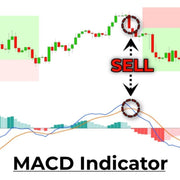
The relative strength index (RSI) is a popular technical indicator used by traders to analyze the strength of a security's price action. It is a momentum indicator that measures the speed and change of price movements.
There are several ways in which the RSI indicator can be used in trading:
Reversals:
-
The relative strength index (RSI) has an overbought level of 70 and an oversold level of 30. When the RSI is above 70, it indicates that the security may be overbought and therefore potentially ready for a price reversal or decline. Conversely, when the RSI is below 30, it suggests that the security may be oversold and potentially ready for a price reversal or rally. This is known as a reversal strategy, which seeks to profit from a change in trend.
However, it is important to note that relying on this strategy to detect a change in trend can be risky, as the trend is generally considered to be a trader's friend. It is generally more advisable to trade with the trend rather than against it. Therefore, it is important for traders to use other technical and fundamental analysis tools in conjunction with the RSI to confirm the validity of a potential trend reversal before making a trade.
Divergences:
- Traders can also use the RSI to identify divergences, which occur when the price of a security moves in the opposite direction of the RSI. A bullish divergence occurs when the price makes a new low, but the RSI makes a higher low, indicating that the underlying strength of the security is improving. A bearish divergence occurs when the price makes a new high, but the RSI makes a lower high, suggesting that the security is losing strength.
Trend confirmation:
- The RSI indicator can be utilized to confirm the direction of a trend. When the RSI is above 50 and increasing, it suggests an uptrend is present. Conversely, if the RSI is below 50 and decreasing, it indicates a downtrend. Some traders may choose to use stricter requirements, such as levels above 70-75 for long positions and below 30-25 for short positions. Additionally, the inclusion of a moving average on the RSI, as is available on some charting platforms like Tradingview, can be useful in determining trend continuation. If the RSI is above its moving average and above 75, it may indicate a strong uptrend. Similarly, if the RSI is below its moving average and below 25, it may indicate a strong downtrend.
Breakouts:
-
Traders can use the RSI indicator to identify potential breakout points in the price of a security. When the RSI is consistently trading within a narrow range, it may indicate that the security is range-bound. A breakout occurs when the price moves outside of this range, either to the upside or the downside. The RSI can detect potential breakout points because it is sensitive to changes in the price of the security. When the RSI breaks out of its own range, it could signal a potential breakout in the price of the security.
In addition to the RSI, traders can also use Bollinger Bands to detect breakouts. Bollinger Bands are a technical analysis tool that consist of a moving average and two standard deviation bands above and below the moving average. When the price of a security moves outside of the Bollinger Bands, it could signify a breakout.
Traders can use both the RSI and Bollinger Bands together to confirm the validity of a breakout. If both indicators show a breakout, it may be more likely that a significant move in the price of the security is occurring.
Support and resistance:
-
Support and resistance are important concepts in technical analysis that refer to price levels at which a security may have difficulty breaking through. Support levels are price levels where demand is thought to be strong enough to prevent the price from falling further. Conversely, resistance levels are price levels where supply is thought to be strong enough to prevent the price from rising further.
The RSI indicator can be used to identify potential support and resistance levels because it is sensitive to changes in the price of a security. If the RSI consistently bounces off a certain level, it may indicate that this level is acting as a support or resistance level for the security.
For example, if the RSI is consistently bouncing off a level of 70, it may indicate that this level is acting as a resistance level for the security. This could be a sign that the security is having difficulty breaking through this level and may be prone to a price decline. Conversely, if the RSI is consistently bouncing off a level of 30, it may indicate that this level is acting as a support level for the security. This could be a sign that the security is finding support at this level and may be ready for a price rally.
Traders can use this information to make informed trading decisions. For example, if the RSI is consistently bouncing off a resistance level, a trader may choose to sell the security or consider shorting it. Conversely, if the RSI is consistently bouncing off a support level, a trader may choose to buy the security in anticipation of a price rally.
It is important to note that support and resistance levels are not fixed and can change over time. Therefore, traders should regularly monitor the RSI and other technical indicators to identify potential changes in support and resistance levels.




Leave a comment